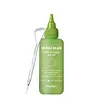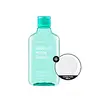What's inside
What's inside
 Key Ingredients
Key Ingredients

 Benefits
Benefits

 Concerns
Concerns

 Ingredients Side-by-side
Ingredients Side-by-side

Water
Skin ConditioningTromethamine
Buffering1,2-Hexanediol
Skin ConditioningButylene Glycol
HumectantArginine
MaskingPropanediol
SolventPolyglyceryl-6 Dicaprate
EmulsifyingPolyacrylate Crosspolymer-6
Emulsion StabilisingMethylpropanediol
SolventDehydroxanthan Gum
Emulsion StabilisingSodium Cocoyl Alaninate
Ethylhexylglycerin
Skin ConditioningVinegar
Vigna Radiata Seed Extract
Skin ConditioningHydrolyzed Sclerotium Gum
HumectantAllantoin
Skin ConditioningDipotassium Glycyrrhizate
HumectantMyosotis Sylvatica Flower/Leaf/Stem Extract
Skin ConditioningHemerocallis Fulva Flower Extract
Skin ConditioningVitis Vinifera Fruit Extract
Skin ConditioningMalus Domestica Fruit Extract
AntioxidantPrunus Mume Fruit Extract
HumectantCarica Papaya Fruit Extract
Skin ConditioningSuccinic Acid
BufferingGluconolactone
Skin ConditioningCitric Acid
BufferingCapryloyl Salicylic Acid
ExfoliatingBetaine Salicylate
AntimicrobialPrunus Amygdalus Dulcis Fruit Extract
Skin ConditioningTremella Fuciformis Extract
HumectantTabebuia Impetiginosa Bark Extract
Skin ConditioningWater, Tromethamine, 1,2-Hexanediol, Butylene Glycol, Arginine, Propanediol, Polyglyceryl-6 Dicaprate, Polyacrylate Crosspolymer-6, Methylpropanediol, Dehydroxanthan Gum, Sodium Cocoyl Alaninate, Ethylhexylglycerin, Vinegar, Vigna Radiata Seed Extract, Hydrolyzed Sclerotium Gum, Allantoin, Dipotassium Glycyrrhizate, Myosotis Sylvatica Flower/Leaf/Stem Extract, Hemerocallis Fulva Flower Extract, Vitis Vinifera Fruit Extract, Malus Domestica Fruit Extract, Prunus Mume Fruit Extract, Carica Papaya Fruit Extract, Succinic Acid, Gluconolactone, Citric Acid, Capryloyl Salicylic Acid, Betaine Salicylate, Prunus Amygdalus Dulcis Fruit Extract, Tremella Fuciformis Extract, Tabebuia Impetiginosa Bark Extract
Water
Skin Conditioning1,2-Hexanediol
Skin ConditioningHamamelis Virginiana Water
AstringentSalvia Officinalis Leaf Extract
CleansingButylene Glycol
HumectantArctium Majus Root Extract
Skin ConditioningChamaecyparis Obtusa Water
MaskingEucalyptus Globulus Leaf Extract
PerfumingMelissa Officinalis Leaf Extract
Skin ConditioningGlycerin
HumectantHypericum Perforatum Flower/Leaf/Stem Extract
Skin ConditioningSaponaria Officinalis Leaf Extract
AntimicrobialSorbitol
HumectantGluconolactone
Skin ConditioningEthylhexylglycerin
Skin ConditioningPropanediol
SolventTrisodium Ethylenediamine Disuccinate
4-Terpineol
MaskingSuccinic Acid
BufferingBetaine
HumectantMelaleuca Alternifolia Leaf Water
AntimicrobialPanthenol
Skin ConditioningHyaluronic Acid
HumectantHydrolyzed Hyaluronic Acid
HumectantSodium Hyaluronate
HumectantPunica Granatum Flower Extract
Skin ConditioningPentylene Glycol
Skin ConditioningCaprylyl Glycol
EmollientWater, 1,2-Hexanediol, Hamamelis Virginiana Water, Salvia Officinalis Leaf Extract, Butylene Glycol, Arctium Majus Root Extract, Chamaecyparis Obtusa Water, Eucalyptus Globulus Leaf Extract, Melissa Officinalis Leaf Extract, Glycerin, Hypericum Perforatum Flower/Leaf/Stem Extract, Saponaria Officinalis Leaf Extract, Sorbitol, Gluconolactone, Ethylhexylglycerin, Propanediol, Trisodium Ethylenediamine Disuccinate, 4-Terpineol, Succinic Acid, Betaine, Melaleuca Alternifolia Leaf Water, Panthenol, Hyaluronic Acid, Hydrolyzed Hyaluronic Acid, Sodium Hyaluronate, Punica Granatum Flower Extract, Pentylene Glycol, Caprylyl Glycol
 Reviews
Reviews

Ingredients Explained
These ingredients are found in both products.
Ingredients higher up in an ingredient list are typically present in a larger amount.
1,2-Hexanediol is a synthetic liquid and another multi-functional powerhouse.
It is a:
- Humectant, drawing moisture into the skin
- Emollient, helping to soften skin
- Solvent, dispersing and stabilizing formulas
- Preservative booster, enhancing the antimicrobial activity of other preservatives
Butylene Glycol (or BG) is used within cosmetic products for a few different reasons:
Overall, Butylene Glycol is a safe and well-rounded ingredient that works well with other ingredients.
Though this ingredient works well with most skin types, some people with sensitive skin may experience a reaction such as allergic rashes, closed comedones, or itchiness.
Learn more about Butylene GlycolEthylhexylglycerin (we can't pronounce this either) is commonly used as a preservative and skin softener. It is derived from glyceryl.
You might see Ethylhexylglycerin often paired with other preservatives such as phenoxyethanol. Ethylhexylglycerin has been found to increase the effectiveness of these other preservatives.
Gluconolactone is a PHA. PHAs are a great gentle alternative to traditional AHAs.
When applied, Gluconolactone has the same affect on skin as AHAs such as lactic acid. It helps dissolve the dead skin cells in the top layer of your skin. This improves texture and brightens the skin.
PHAs are more gentle than AHAs due to their larger structure. They do not penetrate as deeply as AHAs and take a longer time to dissolve dead cells. Studies show PHAs do not cause as much irritation.
Gluconolactone has some interesting properties:
In a 2004 study, Gluconolactone was found to prevent UV damage in mouse skin cells and has not been found to increase sun sensitivity. However, we still recommend wearing SPF daily.
This ingredient is is an created by reacting gluconic acid with an alcohol.
Learn more about GluconolactonePropanediol is an all-star ingredient. It softens, hydrates, and smooths the skin.
It’s often used to:
Propanediol is not likely to cause sensitivity and considered safe to use. It is derived from corn or petroleum with a clear color and no scent.
Learn more about PropanediolSuccinic acid is an odorless white powder. It is naturally found in our bodies but can also be derived from living organisms.
Succinic acid is water-soluble. The pH level of this ingredient is between 4.2 and 5.6.
While succinic acid posesses antimicrobial, antioxidant, and anti-inflammatory properties, these properties have not been studied in skincare products.
Fun fact: Succinic acid was known as the 'spirit of amber' in the past. This is because it used to be derived from distilling amber.
Learn more about Succinic AcidWater. It's the most common cosmetic ingredient of all. You'll usually see it at the top of ingredient lists, meaning that it makes up the largest part of the product.
So why is it so popular? Water most often acts as a solvent - this means that it helps dissolve other ingredients into the formulation.
You'll also recognize water as that liquid we all need to stay alive. If you see this, drink a glass of water. Stay hydrated!
Learn more about Water